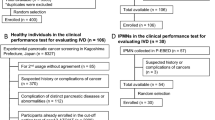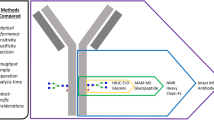Abstract
Strategies to improve the early diagnosis of prostate cancer will provide opportunities for earlier intervention. The blood-based prostate-specific antigen (PSA) assay is widely used for prostate cancer diagnosis but specificity of the assay is not satisfactory. An algorithm based on serum levels of PSA combined with other serum biomarkers may significantly improve prostate cancer diagnosis. Plasma glycan-binding IgG/IgM studies suggested that glycan patterns differ between normal and tumor cells. We hypothesize that in prostate cancer glycoproteins or glycolipids are secreted from tumor tissues into the blood and induce auto-immunoglobulin (Ig) production. A 24-glycan microarray and a 5-glycan subarray were developed using plasma samples obtained from 35 prostate cancer patients and 54 healthy subjects to identify glycan-binding auto-IgGs. Neu5Acα2-8Neu5Acα2-8Neu5Acα (G81)-binding auto-IgG was higher in prostate cancer samples and, when levels of G81-binding auto-IgG and growth differentiation factor-15 (GDF-15 or NAG-1) were combined with levels of PSA, the prediction rate of prostate cancer increased from 78.2% to 86.2% than with PSA levels alone. The G81 glycan-binding auto-IgG fraction was isolated from plasma samples using G81 glycan-affinity chromatography and identified by N-terminal sequencing of the 50 kDa heavy chain variable region of the IgG. G81 glycan-binding 25 kDa fibroblast growth factor-1 (FGF1) fragment was also identified by N-terminal sequencing. Our results demonstrated that a multiplex diagnostic combining G81 glycan-binding auto-IgG, GDF-15/NAG-1 and PSA (≥ 2.1 ng PSA/ml for cancer) increased the specificity of prostate cancer diagnosis by 8%. The multiplex assessment could improve the early diagnosis of prostate cancer thereby allowing the prompt delivery of prostate cancer treatment.




Similar content being viewed by others
References
Ferlay J, Soerjomataram I, Dikshit R, Eser S, Mathers C, Rebelo M, Parkin DM, Forman D, Bray F (2012) Cancer incidence and mortality worldwide: sources, methods and major patterns in GLOBOCAN. Int J Cancer 136(5):E359–E386. https://doi.org/10.1002/ijc.29210
Adhyam M, Gupta AKA (2012) Review on the clinical utility of PSA in cancer prostate. Indian J Surg Oncol 3(2):120–129. https://doi.org/10.1007/s13193-012-0142-6
Kawakami J, Siemens DR, Nickel JC (2004) Prostatitis and prostate cancer: implications for prostate cancer screening. Urology 64:1075. https://doi.org/10.1016/j.urology.2004.07.017
Masahiko N, Hisanori K, Tomihiro T, Oyama R, Imanaka K, Yoshizawa K (2016) Association of early PSA decline and time to PSA progression in abiraterone acetate-treated metastatic castration-resistant prostate cancer; a post-hoc analysis of Japanese phase 2 trials. BMC Urol 16(1):27. https://doi.org/10.1186/s12894-016-0148-4
Lerner L, Tao J, Liu Q, Nicoletti R, Feng B, Krieger B, Mazsa E, Siddiquee Z, Wang R, Huang L, Shen L, Lin J, Vigano A, Chiu MI, Weng Z, Winston W, Weiler S, Gyuris J (2016) MAP3K11/GDF15 axis is a critical driver of cancer cachexia. J Cachexia Sarcopenia Muscle 7(4):467–482. https://doi.org/10.1002/jcsm.12077
Campbell CT, Gulley JL, Oyelaran O, Hodge JW, Schlom J, Gildersleeve JC (2013) Serum antibodies to blood group A predict survival on PROSTVAC-VF. Clin Cancer Res 19(5):1290–1299. https://doi.org/10.1158/1078-0432.CCR-12-2478
Griffin ME, Hsieh-Wilson LC (2016) Glycan engineering for cell and developmental biology. Cell Chem Biol 23(1):108–121. https://doi.org/10.1016/j.chembiol.2015.12.007
Muthana SM, Gulley JL, Hodge JW, Schlom J, Gildersleeve JC (2015) ABO blood type correlates with survival on prostate cancer vaccine therapy. Oncotarget 6(31):32244–32256. https://doi.org/10.18632/oncotarget.4993
Ohyama C, Hosono M, Nitta K, Oh-eda M, Yoshikawa K, Habuchi T, Arai Y, Fukuda M (2004) Carbohydrate structure and differential binding of prostate specific antigen to Maackia amurensis lectin between prostate cancer and benign prostate hypertrophy. Glycobiology 14(8):671–679. https://doi.org/10.1093/glycob/cwh071
Tang X, Mahajan SS, Nguyen LT, Béliveau F, Leduc R, Simon JA, Vasioukhin V (2014) Targeted inhibition of cell-surface serine protease Hepsin blocks prostate cancer bone metastasis. Oncotarget 5(5):1352–1362. https://doi.org/10.18632/oncotarget.1817
Totten SM, Adusumilli R, Kullolli M, Tanimoto C, Brooks JD, Mallick P, Pitteri SJ (2018) Multi-lectin affinity chromatography and quantitative proteomic analysis reveal differential glycoform levels between prostate cancer and benign prostatic hyperplasia Sera. Sci Rep 8(1):6509. https://doi.org/10.1038/s41598-018-24270-w
Wang CC, Huang YL, Ren CT, Lin CW, Hung JT, Yu JC, Yu AL, Wu CY, Wong CH (2008) Glycan microarray of Globo H and related structures for quantitative analysis of breast cancer. Proc Natl Acad Sci USA 105(33):11661–11666. https://doi.org/10.1073/pnas.0804923105
Meany DL, Zhang Z, Sokoll LJ, Zhang H, Chan DW (2009) Glycoproteomics for prostate cancer detection: changes in serum PSA glycosylation patterns. J Proteome Res 8:613–619. https://doi.org/10.1021/pr8007539
Wang X, Yu J, Sreekumar A, Varambally S, Shen R, Giacherio D, Mehra R, Montie JE, Pienta KJ, Sanda MG, Kantoff PW, Rubin MA, Wei JT, Ghosh D, Chinnaiyan AM (2005) Autoantibody signatures in prostate cancer. N Engl J Med 353(12):1224–1235. https://doi.org/10.1056/NEJMoa051931
Seurynck-Servoss SL, White AM, Baird CL, Rodland KD, Zangar RC (2007) Evaluation of surface chemistries for antibody microarrays. Anal Biochem 371(1):105–115. https://doi.org/10.1016/j.ab.2007.07.010
Horninger W, Cheli CD, Babaian RJ, Fritsche HA, Lepor H, Taneja SS, Childs S, Stamey TA, Sokoll LJ, Chan DW, Brawer MK, Partin AW, Bartsch G (2002) Complexed prostate-specific antigen for early detection of prostate cancer in men with serum prostate-specific antigen levels of 2 to 4 nanograms per milliliter. Urology 60(4 Suppl 1):31–35. https://doi.org/10.1016/s0090-4295(02)01693-x
Liu X, Tang J, Fei X, Li QY (2015) Prostate-specific antigen (PSA) density and free to total PSA ratio in diagnosing prostate cancer with prostate-specific antigen levels of 4.0 ng/ml or less. Iran J Public Health 44(11):1466–1472
Bruzzese F, Hägglöf C, Leone A, Sjöberg E, Roca MS, Kiflemariam S, Sjöblom T, Hammarsten P, Egevad L, Bergh A, Ostman A, Budillon A, Augsten M (2014) Local and systemic protumorigenic effects of cancer-associated fibroblast-derived GDF15. Cancer Res 74(13):3408–3417. https://doi.org/10.1158/0008-5472.CAN-13-2259
Vaňhara P, Hampl A, Kozubík A, Souček K (2012) Growth/differentiation factor-15: prostate cancer suppressor or promoter? Prostate Cancer Prostatic Dis 15(4):320–328. https://doi.org/10.1038/pcan.2012.6
Bauskin AR, Brown DA, Kuffner T, Johnen H, Luo XW, Hunter M, Breit SN (2006) Role of macrophage inhibitory cytokine-1 in tumorigenesis and diagnosis of cancer. Cancer Res 66(10):4983–4986. https://doi.org/10.1158/0008-5472.CAN-05-4067
Brown DA, Stephan C, Ward RL, Law M, Hunter M, Bauskin AR, Amin J, Jung K, Diamandis EP, Hampton GM, Russell PJ, Giles GG, Breit SN (2006) Measurement of serum levels of macrophage inhibitory cytokine 1 combined with prostate-specific antigen improves prostate cancer diagnosis. Clin Cancer Res 12:89–96. https://doi.org/10.1158/1078-0432.CCR-05-1331
Stephan C, Xu C, Brown DA, Breit SN, Michael A, Nakamura T, Diamandis EP, Meyer H, Cammann H, Jung K (2006) Three new serum markers for prostate cancer detection within a percent free PSA-based artificial neural network. Prostate 66(6):651–659. https://doi.org/10.1002/pros.20381
Jiang T, Su C, Ren S, Cappuzzo F, Rocco G, Palmer JD, van Zandwijk N, Blackhall F, Le X, Pennell NA, Zhou C (2018) A consensus on the role of osimertinib in non-small cell lung cancer from the AME Lung Cancer Collaborative Group. J Thorac Dis 10(7):3909–3921. https://doi.org/10.21037/jtd.2018.07.61
Tysarowski A, Nasierowska-Guttmejer A (2018) Quality and practical aspects of pathological and molecular diagnostics in metastatic colorectal cancer (mCRC). Contemp Oncol (Pozn) 22(2):75–85. https://doi.org/10.5114/wo.2018.77047
Reuschenbach M, von Knebel DM, Wentzensen N (2009) A systematic review of humoral immune responses against tumor antigens. Cancer Immunol Immunother 58(10):1535–1544. https://doi.org/10.1007/s00262-009-0733-4
Sauer U (2017) Analytical protein microarrays: advancements towards clinical applications. Sensors 17(2):256. https://doi.org/10.3390/s17020256
Srinivasan S, Clements JA, Batra J (2016) Single nucleotide polymorphisms in clinics: fantasy or reality for cancer? Crit Rev Clin Lab Sci 53(1):29–39. https://doi.org/10.3109/10408363.2015.1075469
He XX, Du S, Gao SQ, Chen JY, Cao RJ, Xing ZK, Kazim ARS, Yu HL, Zheng QC, Zhu XJ (2018) Humanization of fibroblast growth factor 1 single-chain antibody and validation for its antitumorigenic efficacy in breast cancer and glioma cells. J Cell Mol Med 22(6):3259–3263. https://doi.org/10.1111/jcmm.13547
Li J, Chen H, Li X, Wang L, Gao A, Zhang P, Lin W, Gao W, Yang D, Guo X, Liu J, Dang Q, Sun Y (2017) Co-expression of podoplanin and fibroblast growth factor 1 predicts poor prognosis in patients with lung squamous cell carcinoma. Mol Med Rep 16(2):1643–1652. https://doi.org/10.3892/mmr.2017.6830
Udayakumar TS, Nagle RB, Bowden GT (2004) Fibroblast growth factor-1 transcriptionally induces membrane type-1 matrix metalloproteinase expression in prostate carcinoma cell line. Prostate 58(1):66–75. https://doi.org/10.1002/pros.10293
Acknowledgements
This study was supported by NIH/NCI SBIR Phase I Grant, CA159721 (HK).
Author information
Authors and Affiliations
Corresponding author
Ethics declarations
Conflict of interest
Benjamin A. Rybicki, German Perez Bakovic and Shannon L. Servoss declare that they have no competing interests. Hyesook Kim is the president of Detroit R&D, Inc. and has a commercial interest. David J. Kaplan, Aby Joiakim, Julia M. Santos and David A. Putt also work for Detroit R&D, Inc. Alan A. Dombkowski is a board member for Detroit R&D, Inc.
Additional information
Publisher's Note
Springer Nature remains neutral with regard to jurisdictional claims in published maps and institutional affiliations.
Rights and permissions
About this article
Cite this article
dos Santos, J.M., Joiakim, A., Kaplan, D.J. et al. Levels of plasma glycan-binding auto-IgG biomarkers improve the accuracy of prostate cancer diagnosis. Mol Cell Biochem 476, 13–22 (2021). https://doi.org/10.1007/s11010-020-03876-7
Received:
Accepted:
Published:
Issue Date:
DOI: https://doi.org/10.1007/s11010-020-03876-7




